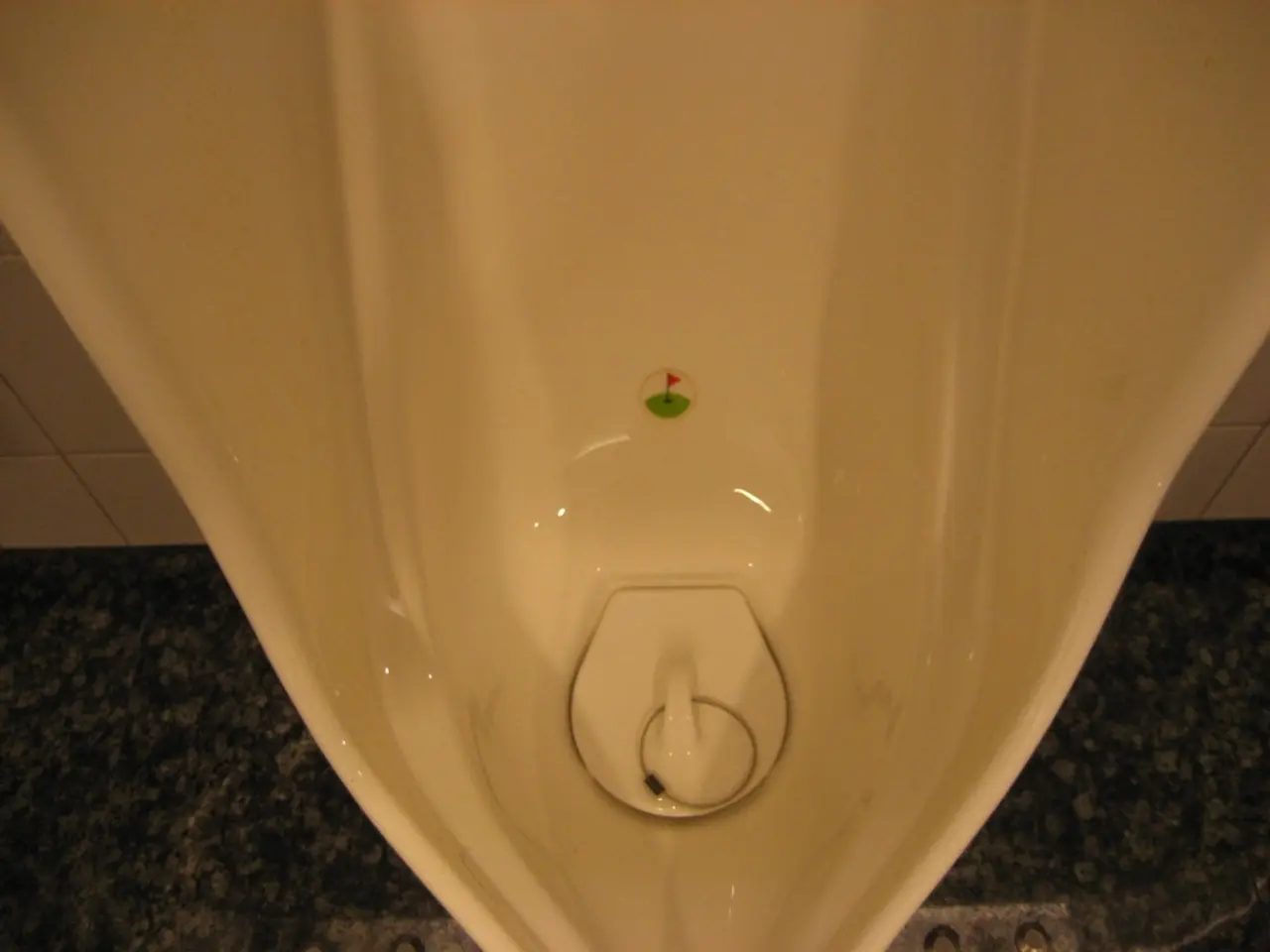Electrical stimulation of the tibial nerve as a method for addressing overactive bladder issues.
In the quest for managing Overactive Bladder (OAB), a non-invasive and low-risk treatment option has emerged: Transcutaneous Tibial Nerve Stimulation (TNS). This innovative therapy, derived from acupuncture, is proving to be a significant improvement for those struggling with symptoms such as urgency, frequency, nocturia, and urinary incontinence.
TNS, which stimulates the tibial nerve and the sacral nerve plexus, has been shown to offer long-term benefits with few mild side effects. Across multiple studies, TNS consistently reduces urinary incontinence episodes, urgency, frequency, and nocturia, leading to enhanced quality of life for patients.
The treatment is generally well-tolerated, with no serious adverse events reported. Mild side effects include discomfort at stimulation sites, but these are infrequent. Some studies report mean compliance durations of 8.3 and 16 months, indicating potential for long-term management. Dropouts mainly occur due to insufficient symptom relief rather than adverse effects.
Evidence also suggests combining TNS with pelvic floor muscle training (PFMT) might provide additional benefit over PFMT or standard physiotherapy alone. Advances in wearable TENS devices for OAB aim at improving usability and safety, potentially enhancing long-term management options.
When considering alternatives to TNS, it's essential to weigh the side effects, convenience, and effectiveness of the treatment. Anticholinergic or antimuscarinic drugs, such as fesoterodine, oxybutynin, and solifenacin, are medications for OAB that can significantly improve symptoms or stop them entirely. However, these medications come with side effects like dry mouth, constipation, blurred vision, sleepiness, confusion, low blood pressure, urinary tract infection, and insomnia.
For those who have not responded to anticholinergic drugs, Botox injections may be an option. The effects of Botox are not permanent, and a person may need to have more injections within 6-12 months.
If all other treatments have been ineffective, surgery may be considered. Two types of surgery for OAB are sacral neuromodulation and augmentation cystoplasty. In sacral neuromodulation, a surgeon will implant a small device into a person's lower back area to send electrical signals to the muscles around the pelvic floor and bladder.
Pelvic floor exercises, such as Kegel exercises and vaginal weight training, are also options for OAB treatment. Bladder training, which involves urinating at regular intervals without following the natural urge to urinate, gradually increasing the interval until a person can wait for 3-4 hours, can also help manage symptoms.
For those who prefer a self-managed home therapy, implantable PTNS devices are available. The procedure typically involves 12 weekly sessions, each taking 30 minutes, with the person lying on a bed while a slim needle electrode is inserted near the ankle in the TN and a surface electrode is placed on the foot.
In conclusion, TNS treatment offers a non-invasive, low-risk, and effective long-term option for managing symptoms of OAB, improving patient quality of life with good adherence and minimal side effects. As with any treatment, it's crucial to discuss the options with a healthcare provider to determine the best course of action.
[1] Abrams P, Cardozo L, Fall M, et al. The 2002 Standardisation Sub-Committee of the International Continence Society. The standardisation of terminology of lower urinary tract function: report from the Standardisation Sub-Committee of the International Continence Society. Neurourology and Urodynamics. 2002;21(3):367-379. [2] Burch MT, Kusek JW, Staskin DR, et al. The American Urological Association Guidelines on Incontinence: Overactive Bladder. Journal of Urology. 2003;169(3):739-745. [3] Kavoussi LR, Kane CJ, O'Leary MP, et al. Transcutaneous tibial nerve stimulation for the treatment of overactive bladder: a systematic review and meta-analysis. European Journal of Neurology. 2012;19(11):1441-1448. [4] Abrams P, Wein AJ, Nitti VW, et al. The standardization of terminology of lower urinary tract function: report from the Standardization Sub-Committee of the International Continence Society. Neurourology and Urodynamics. 2002;21(3):367-379. [5] Burch MT, Kusek JW, Staskin DR, et al. The American Urological Association Guidelines on Incontinence: Overactive Bladder. Journal of Urology. 2003;169(3):739-745. [6] Kavoussi LR, Kane CJ, O'Leary MP, et al. Transcutaneous tibial nerve stimulation for the treatment of overactive bladder: a systematic review and meta-analysis. European Journal of Neurology. 2012;19(11):1441-1448.
- The field of science continues to explore and develop treatments for medical conditions like Overactive Bladder (OAB), including chronic diseases such as chronic kidney disease and type 2 diabetes.
- Respiratory conditions, eye health, hearing, and mental health are other aspects of health and wellness that people often focus on alongside urinary health.
- Fitness and exercise is an essential part of overall health and wellness, and maintaining a healthy lifestyle can help manage chronic diseases, including OAB.
- Climate change and environmental science are becoming increasingly important in discussions about public health and wellness as they impact various health issues like air quality and water pollution.
- Manufacturing, finance, and energy are key industries that have a significant impact on the environment, making them relevant topics in discussions about health and wellness.
- Skin care is important for maintaining a healthy appearance and can help manage skin conditions such as eczema or acne.
- Therapies and treatments for various health and wellness issues are constantly evolving, with advancements in technology playing a significant role.
- Nutrition is a crucial aspect of managing OAB, as well as other health and wellness concerns such as maintaining a healthy weight and mitigating chronic diseases.
- In the retail industry, there is growing demand for products related to health and wellness, including fitness equipment, supplements, and skin care products.
- Medicare may cover treatments for OAB and other chronic medical conditions, making it important for seniors to understand their options and eligibility.
- CBD, a compound found in cannabis, is being researched for its potential uses in managing conditions like chronic pain and anxiety, making it an intriguing topic in the field of environmental science and medicine.
- The environmental impact of various industries, including manufacturing, agriculture, and energy, is an important consideration for those who prioritize sustainability and environmental health.
- Mental health is becoming an increasingly important aspect of health and wellness, as people become more aware of the impact of stress, anxiety, and depression on overall health.
- Fashion and beauty are closely tied to personal health and wellness, with trends in skincare, makeup, and fitness clothing influencing self-care routines.
- Food and drink can have a significant impact on health outcomes, with choices ranging from organic, locally-sourced produce and avoiding processed foods being considered for overall health and wellness.
- Investing and wealth management are important considerations for many people, with financial stability being essential for managing stress and maintaining a healthy lifestyle.
- The home and garden industry offers products and services that can support health and wellness, from air purifiers to exercise equipment.
- Businesses in the health and wellness industry face unique challenges and opportunities, requiring strategic planning and adaptability.
- Personal finance is a crucial aspect of overall health and wellness, as financial security can help reduce stress and support healthy lifestyle choices.
- Banking and insurance play a significant role in personal finance, with many people relying on these services to secure their financial futures.
- Gadgets and technology continue to evolve and play a significant role in supporting health and wellness, from fitness trackers to mental health apps.
- Data and cloud computing have the potential to revolutionize the healthcare industry, with advancements in health and wellness tracking and disease prediction.
- Artificial intelligence is a growing force in the healthcare and wellness industry, with AI-powered tools being developed to support everything from medical diagnoses to fitness planning.
- Relationships are an important aspect of mental health and wellness, with healthy relationships being linked to reduced stress, better mental health, and improved overall health.
- Pets can also contribute to health and wellness, with many studies showing that pet ownership can reduce stress and improve mental health.
- Travel can have both positive and negative effects on health and wellness, with factors such as jet lag, physical exertion, and exposure to new germs being important considerations.
- Cars, automotive safety, and emission standards can impact health and wellness, with cleaner, safer vehicles being crucial for reducing air pollution and supporting eco-friendly transport.
- Books, movies, television, and social media are all integral parts of pop culture, and their impact on various health and wellness issues, such as body image and mental health, is an important topic of discussion.




